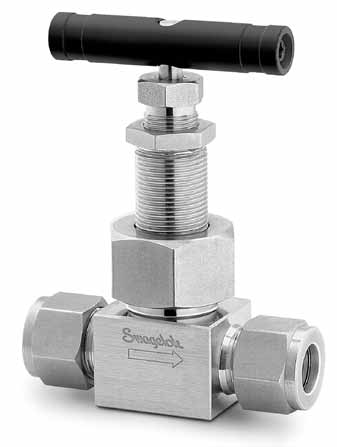Which Valve is Right for My Application?

Which Valve is Right for My Application?
Written by: Mark Starnes, Northeast Georgia Account Manager | September 2019
Many engineers and technicians often ask for our suggestions on what is the best Regulating Valve for them. Swagelok offers many different styles and options making that an understandable inquiry to find the right valve for their application. Below are some common issues customer face with failing regulating valves and how they can be overcome.
After a while, my valves are hard to turn, and I have to replace. How can we avoid this problem?
This is a symptom of the stem threads being exposed to the system media, and the lubricant is being removed as a result. The loss of this lubricant leads to stem thread galling and poor performance in the actuation of the valve.
SOLUTION: Select a valve with a design where the stem packing is located BELOW the stem threads. This will isolate the threads from the system media, eliminate the washing away of the stem lubricant, and extend the cycle life of the valve.
My valves leak out of the stem. What causes that, and how can I fix this?
Most all stem leaks are due to failure of the stem packing/seal material. Picture a doughnut where the valve stem is inserted through the hole. Over time as the stem rotates in actuation, the inner wall of the packing (doughnut) wears away. Most folks will tighten the packing nut and squeeze the seal material into the inner void, and the seal is made around the valve stem. However, this is not a complete solution as this added force increases the torque to turn the valve stem and the wearing away if the inner "hole" is enhanced, leading to another leak.
SOLUTION: Consider a valve with Live loaded stem packing. Live loaded packing designs apply sealing forces on the valve stem independent of a force that is applied from a solid seal material. This gives longer cycle life of the valve and ease of actuation without wearing away the inner “hole” of the seal material
The regulating valves I have do not give me much flow control. It's either too much or not enough.
We often see this is the result of incomplete valve selection and lack of understanding of the flow dynamics of the valve. Many times, valves are selected on their pressure and temperature ratings, but with flow control, one needs to see how the stem tip design will affect the flow control. Many regulating valves come with a standard flat stem tip, but many also come with regulating and vee stem tip designs which produce a variety of flow control capabilities.
SOLUTION: Check the flow curves of the valve you wish to consider. Note the flow rates as a function of turns to open, and this will help dial in the desired stem tip design for the application. Operating within the middle of the span gives the user the most control of the flow.
Understanding the application, and how these valves are to be used, is most critical in deciding which valve to select. Sure, we will ask many questions, but we also want to ensure you enjoy and realize the quality and performance you expect from Swagelok products.
For more information or help selecting a valve, contact your local Swagelok Representative. We are here to help.
